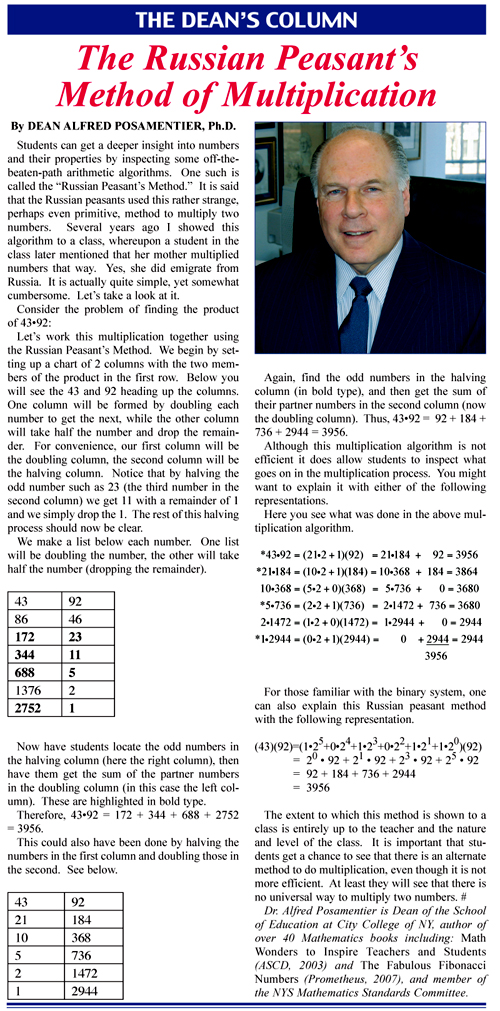
The DEAN’S COLUMN
The Russian Peasant’s Method of Multiplication
By Dean Alfred Posamentier, Ph.D.
Students can get a deeper insight into numbers and their properties by inspecting some off-the-beaten-path arithmetic algorithms. One such is called the “Russian Peasant’s Method.” It is said that the Russian peasants used this rather strange, perhaps even primitive, method to multiply two numbers. Several years ago I showed this algorithm to a class, whereupon a student in the class later mentioned that her mother multiplied numbers that way. Yes, she did emigrate from Russia. It is actually quite simple, yet somewhat cumbersome. Let’s take a look at it.
Consider the problem of finding the product of 43•92:
Let’s work this multiplication together using the Russian Peasant’s Method. We begin by setting up a chart of 2 columns with the two members of the product in the first row. Below you will see the 43 and 92 heading up the columns. One column will be formed by doubling each number to get the next, while the other column will take half the number and drop the remainder. For convenience, our first column will be the doubling column, the second column will be the halving column. Notice that by halving the odd number such as 23 (the third number in the second column) we get 11 with a remainder of 1 and we simply drop the 1. The rest of this halving process should now be clear.
We make a list below each number. One list will be doubling the number, the other will take half the number (dropping the remainder).
43 |
92 |
86 |
46 |
172 |
23 |
344 |
11 |
688 |
5 |
1376 |
2 |
2752 |
1 |
Now have students locate the odd numbers in the halving column (here the right column), then have them get the sum of the partner numbers in the doubling column (in this case the left column). These are highlighted in bold type.
Therefore, 43•92 = 172 + 344 + 688 + 2752 = 3956.
This could also have been done by halving the numbers in the first column and doubling those in the second. See below.
43 |
92 |
21 |
184 |
10 |
368 |
5 |
736 |
2 |
1472 |
1 |
2944 |
Again, find the odd numbers in the halving column (in bold type), and then get the sum of their partner numbers in the second column (now the doubling column). Thus, 43•92 = 92 + 184 + 736 + 2944 = 3956.
Although this multiplication algorithm is not efficient it does allow students to inspect what goes on in the multiplication process. You might want to explain it with either of the following representations.
Here you see what was done in the above multiplication algorithm.
For those familiar with the binary system, one can also explain this Russian peasant method with the following representation.
(43)(92)=(1•25+0•24+1•23+0•22+1•21+1•20)(92)
= 20 • 92 + 21 • 92 + 23 • 92 + 25 • 92
= 92 + 184 + 736 + 2944
= 3956
The extent to which this method is shown to a class is entirely up to the teacher and the nature and level of the class. It is important that students get a chance to see that there is an alternate method to do multiplication, even though it is not more efficient. At least they will see that there is no universal way to multiply two numbers. #
Dr. Alfred Posamentier is Dean of the School of Education at City College of NY, author of over 40 Mathematics books including: Math Wonders to Inspire Teachers and Students (ASCD, 2003) and The Fabulous Fibonacci Numbers (Prometheus, 2007), and member of the NYS Mathematics Standards Committee.
